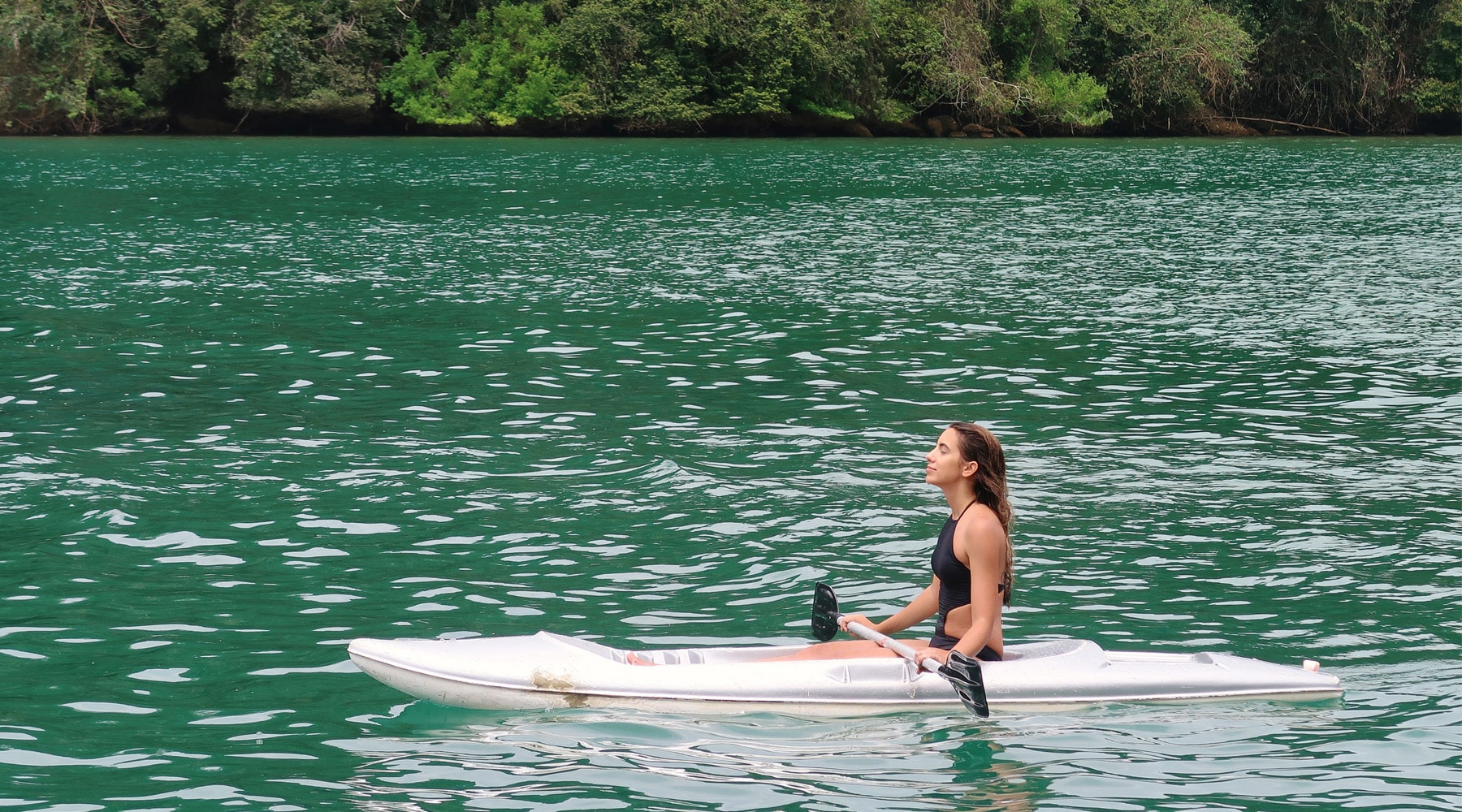Ilha Grande is a pristine island off the coast of Rio de Janeiro state, Brazil, famed for its white-sand beaches, crystal-clear waters, and verdant rainforest interior. Long isolated from development, this 193 km² island remained an unspoiled natural haven – a fact recognized when Ilha Grande and the nearby colonial town of Paraty were inscribed as a UNESCO World Heritage Site in 2019.
Today, it’s often hailed as “one of the safest places in Brazil”, inviting everyone from solo backpackers to families to discover its jungled trails and secluded coves. This comprehensive guide covers everything you need to know before visiting Ilha Grande – from getting there and the best time to go, to top attractions (yes, including Ilha Grande’s sharks and safety tips!), plus handy advice to make the most of your island adventure.
A Brief History of Ilha Grande
Ilha Grande hasn’t always been the inviting paradise it is now. In the 19th century, the island served as a quarantine for leprosy patients, and later became the site of a notorious maximum-security prison that held Brazil’s most dangerous criminals. During those decades, the island was strictly off-limits to visitors. The last prison (the Cândido Mendes penal colony at Dois Rios Beach) was only shut down in 1994.
This dark past had a silver lining: decades of limited human presence kept Ilha Grande’s ecosystems largely untouched. Soon after the prison closed, travelers began flocking to the island for its “unspoiled nature”. The ruins of the old penitentiary can still be seen today at Dois Rios, but instead of guards and inmates, you’ll now find curious hikers and a small museum documenting the island’s history. Thanks to its unique heritage and biodiversity, Ilha Grande – together with historic Paraty – was designated a UNESCO World Heritage Site, celebrated for its blend of culture and biodiversity.
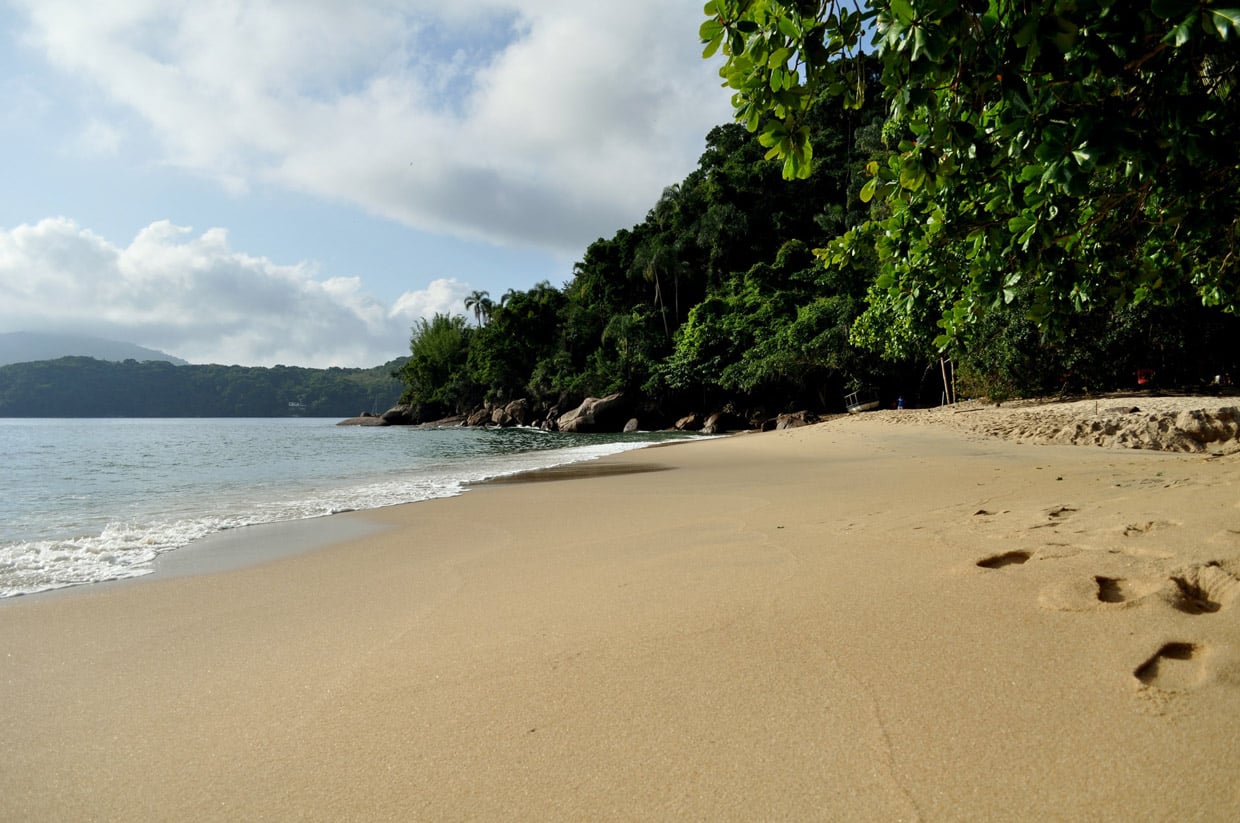
How to Get to Ilha Grande
Reaching Ilha Grande is part of the adventure, as there are no bridges or airports on the island. The journey typically involves traveling to a coastal port and then taking a boat/ferry to the island. Here are the most common ways to get there:
- From Rio de Janeiro: Ilha Grande lies about 150 km (95 mi) west of the city. The easiest option from Rio is an all-in-one shuttle transfer (van + ferry), which many hotels and tour agencies can arrange. These transfers pick you up in Rio (often from your hotel or the airport) and take you to the port (such as Conceição de Jacareí or Angra dos Reis) to catch the ferry or speedboat to Ilha Grande. This package is surprisingly cost-effective and hassle-free – you can even book it online in advance (commonly available on travel sites). The shuttle + boat ride from Rio takes roughly 3 to 4 hours in total.
- DIY Travel: For a more budget approach, you can take a public bus from Rio’s main bus terminal (Rodoviária Novo Rio) to one of the ferry ports: Conceição de Jacareí, Angra dos Reis, or Mangaratiba. Buses (like the Costa Verde line) run regularly and cost around R$60 (≈ $12 USD) to Angra or Conceição. From these towns, ferries and speedboats depart to Vila do Abraão (Ilha Grande’s main village) multiple times a day. Conceição de Jacareí is the closest and most popular ferry point – the boat from there takes only 20–30 minutes to Ilha Grande. Angra and Mangaratiba have slightly longer ferry rides (around 60–90 minutes). Once you arrive at the port, just buy a ferry ticket at the dock (around R$70–R$100, ≈ $14–$20 USD, one-way). No need to book the public ferries far ahead, except on major holidays.
- From São Paulo or Paraty: If you’re coming from elsewhere, you can also reach Ilha Grande via the same ports. Buses run from São Paulo to Angra dos Reis (an 8–9 hour ride) and from the colonial town of Paraty to Angra or Conceição in a few hours. Many travelers coming down the coast simply stop in Paraty, then continue on to Ilha Grande. Check schedules on travel planning sites like Rome2Rio or local bus company sites, and plan to arrive at the port in time for an afternoon boat (as ferries don’t run late at night).
Tip: If you’re short on time or prefer convenience, it’s even possible to visit Ilha Grande on a day trip from Rio – boat tour companies offer long day tours that leave pre-dawn and return at night. However, a day trip hardly does the island justice. It’s far better to stay a few days and truly soak in the tropical vibes (more on how long to stay and what to do coming up next!).
Best Time to Visit Ilha Grande
Ilha Grande is blessed with a warm, humid climate year-round, but there are noticeable seasonal differences in rainfall, temperatures, and crowds. Your ideal time to visit will depend on your priorities:
- Summer (December–February): This is Brazilian summer and peak tourist season. Expect hot temperatures (average highs around 26–28 °C (79–82 °F) in summer months) with very humid, rainy weather. In fact, December through February are the rainiest months, each seeing ~180–250 mm (7–10 inches) of rainfall on average. Tropical downpours are common, especially in the afternoons. On the plus side, the ocean is at its warmest (water temp ~24–26 °C) and the island buzzes with energy during the holidays and Carnival. If you visit in this period, plan for some rain delays and book accommodation well in advance (Christmas, New Year and Carnival weeks are extremely busy).
- Autumn (March–May) and Spring (September–November): These shoulder seasons often offer a great balance. Temperatures are a tad cooler (daytime highs ~23–27 °C, nights 13–18 °C) but still very pleasant. Rainfall is moderate – you’ll still get some showers, but far less than mid-summer (around 80–140 mm per month). April–May and Sept–Oct in particular can be lovely: the island is quieter after high season, prices drop, and you’ll enjoy mostly sunny days without the huge crowds. For many travelers, April and October hit the sweet spot of good weather and fewer tourists.
- Winter (June–August): Winter in Ilha Grande is mild and actually the driest period. Average highs hover around 21–23 °C (70–73 °F), with cooler nights down to 11–15 °C. Rain is minimal (as little as 50–60 mm per month, so some winter months are 3–4 times drier than summer). You’ll enjoy clear skies and excellent hiking conditions. The trade-off is the ocean is cooler (water ~21 °C in winter) – still swimmable for most, but a bit brisk. Beaches will be quieter and some boat tours less frequent in winter, but overall it’s a fine time to visit if you prefer tranquility. Just bring a light jacket for the evening.
In summary: Ilha Grande is an all-year destination, but if you want beach-perfect weather with fewer crowds, aim for late spring or early autumn (e.g. November or April). If snorkeling and swimming in bath-warm water is a priority, the Brazilian summer (Dec–Feb) offers the warmest seas – just be ready for intermittent rain. And if you’re a hiker who dislikes heat and humidity, the cooler, dry winter months (Jun–Aug) are ideal for tackling the trails. Whenever you go, the island’s beauty is sure to shine – just pack accordingly (always bring sunscreen and insect repellent) and embrace the laid-back island pace.
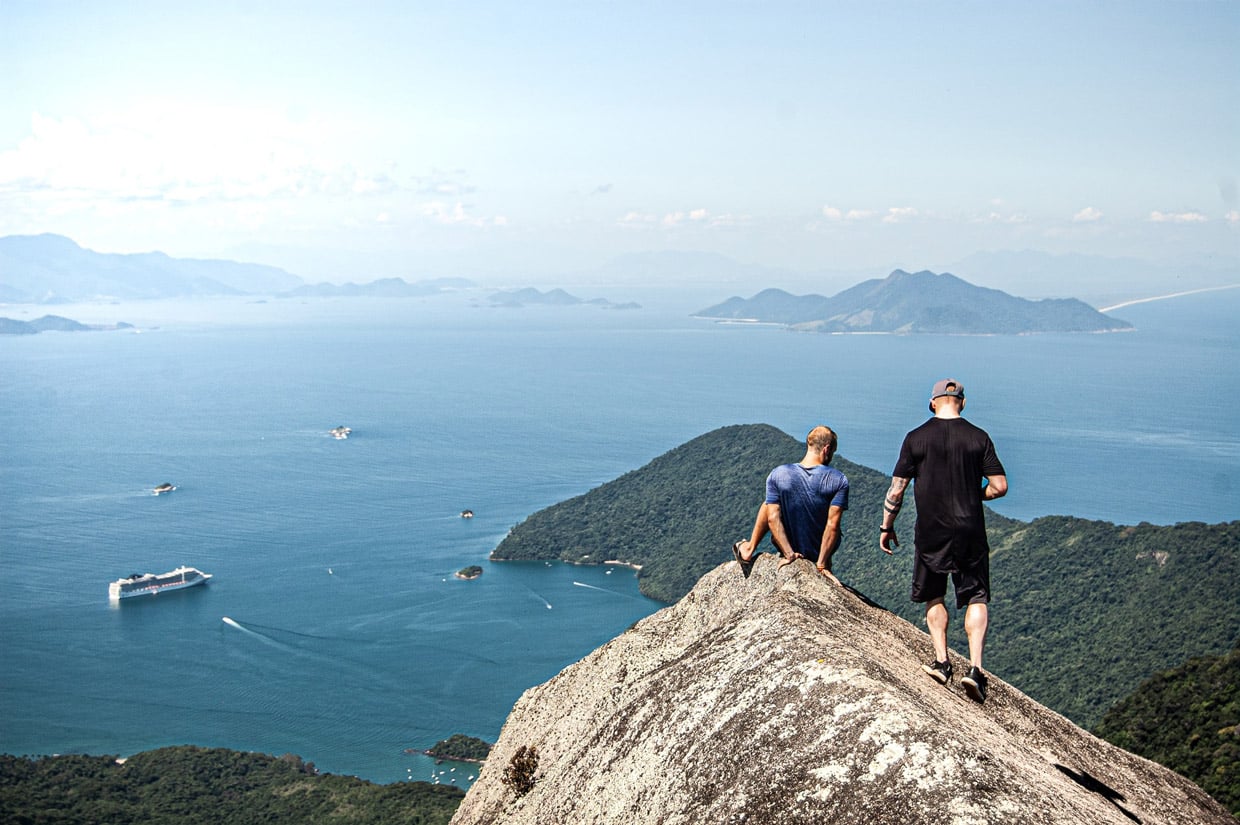
Where to Stay on Ilha Grande
Nearly all visitors stay in or near Vila do Abraão, the main village and port on the island. Abraão is Ilha Grande’s small but bustling hub – it’s where the ferries dock, and you’ll find the highest concentration of guesthouses (pousadas), hostels, restaurants, and tour offices here. For most travelers, staying in Abraão is most convenient. From Abraão, you can easily arrange boat trips and reach several trailheads; plus, the village has a charming beachside vibe in the evenings with live music, beach bars, and storefronts opening onto pedestrian lanes (remember, no cars!). Accommodation ranges from budget backpacker hostels (e.g. the popular Biergarten Hostel) to mid-range pousadas and a few boutique hotels. Many are small family-run places – expect simple comforts rather than big resorts, which thankfully don’t exist here.
If you’re seeking more solitude or a unique stay, there are a handful of lodgings outside Abraão. These include secluded beachfront inns and eco-lodges around the island (for example, a couple of guesthouses at Praia Vermelha, Enseada do Bananal, or Araçatiba on the far side). These can offer a true “get away from it all” experience – imagine stepping off your porch onto a quiet beach with jungle all around. Just note that if you stay outside the main village, you’ll be reliant on boat taxis (or long hikes) to get to Abraão or between locations. It’s a trade-off of seclusion for convenience.
Camping: There are also campsites on Ilha Grande, particularly at Praia do Aventureiro (which is famed for its postcard-perfect bent palm tree). Camping numbers are limited by permit in some areas, so inquire locally or via the park administration if you plan to camp. Most casual travelers opt for a roof over their heads in Abraão, but adventurous souls and budget campers do have options.
Tip: Book accommodations in advance for peak periods (summer holidays and weekends). During New Year’s, Carnival, and Brazilian long weekends, affordable rooms can sell out as many locals and international visitors descend on the island. In quieter months, you can often find a place on arrival, but it’s still wise to have at least the first night sorted, especially if arriving late.
Top Things to Do in Ilha Grande
Ilha Grande may be relatively small, but it bursts with activities for nature lovers, beach bums, and adventure seekers. Here are the top things to see and do:
- Relax on Stunning Beaches: Ilha Grande’s beaches are the star attraction – there are over 100 beaches ranging from lively to completely isolated. The most famous is Lopes Mendes Beach, a 3-km stretch of powdery white sand often voted one of Brazil’s most beautiful beaches. Lopes Mendes has no development (no hotels or restaurants – just sand, sea, and forest), so it feels like a true tropical paradise. You can reach it by hiking ~2 hours through the jungle from Abraão or by taking a taxi-boat to a nearby beach and walking 20 minutes. Either way, the reward is a gorgeous beach with clear aquamarine water and consistent waves that are fun for bodysurfing or beginner surfing.
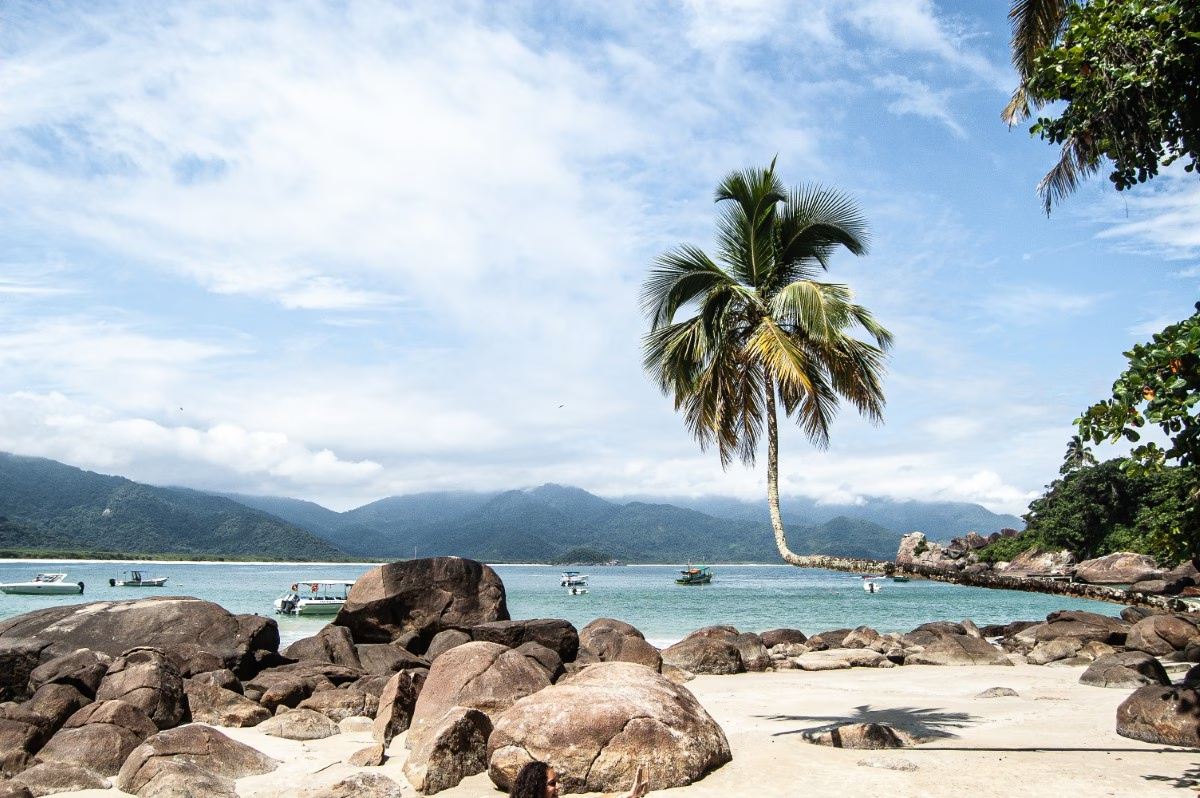
- Other notable beaches include Dois Rios (a long beach near the old prison ruins – wonderfully quiet, with a small research station/museum), Praia do Aventureiro (famous for that leaning palm tree – a favorite photo spot; limited to 560 visitors per day for conservation), Praia da Feiticeira (small beach near a waterfall), and Lagoa Azul and Lagoa Verde, which are actually calm blue lagoons perfect for snorkeling. If you have time, consider an around-the-island boat tour which stops at many beautiful beaches and bays (like Caxadaço, Parnaioca, and Aventureiro), giving you a taste of multiple slices of paradise in one day. No matter which beach you choose, expect soft sand, clean warm water, and lush jungle backdrops – the island’s beaches remain relatively undeveloped and pristine.
- Hike the Jungle Trails: With no roads or cars, hiking is one of the best ways to explore Ilha Grande. The island is crisscrossed by well-marked dirt trails connecting beaches, peaks, and villages. One iconic trek is the Pico do Papagaio hike – a challenging uphill climb (2–3 hours one-way) through dense Atlantic Forest to the highest peak, Pico do Papagaio (Parrot Peak, 982 m). Do a pre-dawn hike (best with a guide unless you’re an experienced trekker) to catch a spectacular sunrise from the summit, with panoramic views over the island and ocean – an unforgettable experience if weather permits. Other popular walks include the Abraão to Lopes Mendes trail (through forest and along a series of beaches), the hike to Dois Rios (flat 1.5–2 hour trail to the prison ruins and beach), and shorter jaunts like the Abraão Circuit, which leads to the Aqueduct ruins and Feiticeira Waterfall. The rainforest scenery is breathtaking – think tropical foliage, monkeys swinging in the canopy, hummingbirds and butterflies, and the distant sound of surf as you approach each new beach. Trails are generally safe and well-trodden, but always bring water, wear good shoes (no flip-flops on long hikes – many have learned this the hard way!), and start hikes early enough to return before dark. Also, insect repellent is a must in the forests to keep mosquitoes at bay.
- Boat Trips & Snorkeling: To fully appreciate Ilha Grande, get out on the water. Numerous boat tours depart daily from Abraão – ranging from half-day schooner trips to specific spots, to full-day excursions circling the island. A favorite is the tour to Lagoa Azul (Blue Lagoon), a sheltered bay with crystal-clear water teeming with tropical fish. Armed with a snorkel mask, you can float among parrotfish, sergeant majors, angelfish, and even spot sea turtles and starfish. Nearby Lagoa Verde (Green Lagoon) is another calm snorkeling haven with lots of colorful marine life. Don’t worry if you didn’t pack snorkel gear – many tours include masks, or you can rent one cheaply in town (or bring your own for convenience).
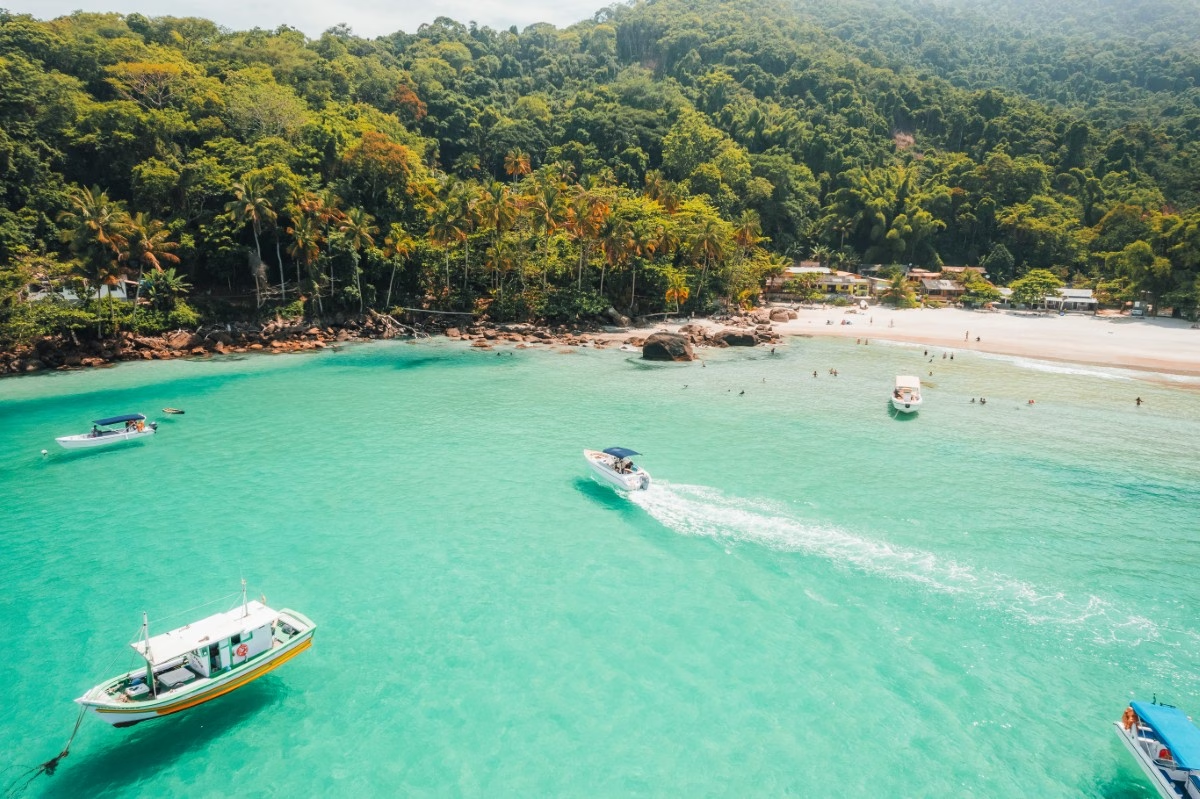
- Aside from the lagoons, boat tours often stop at picturesque beaches for swimming and relaxation, and some include a simple lunch. Another option is hiring a taxi-boat to reach specific spots on your own schedule (for example, catch a boat to Pouso Beach and then hike 15 minutes to Lopes Mendes). For the adventurous, scuba diving is available too – Ilha Grande’s dive sites feature rocky reefs, shipwrecks, and abundant sea life. The waters aren’t Caribbean-clear, but visibility of 5–15 meters is common, and divers often see moray eels, turtles, rays, huge schools of fish, and occasional small reef sharks. Local dive operators (like Aquamarina Mergulho) can take both certified divers and beginners (intro dives). Whether you snorkel or dive, you’ll discover Ilha Grande’s marine world is rich and vibrant – a wonderful complement to its beaches and forests.
- Wildlife & Nature Watching: The entire island is a protected state park and biosphere reserve, home to countless species. Just walking around, you’re likely to encounter mischievous monkeys (often capuchins) trying to steal fruit from trees, tropical birds like toucans and tanagers flitting about, and perhaps a lazy sloth hanging from a branch. At night, you might hear the chorus of coquí frogs and see constellations of stars (the lack of street lights outside the village makes for great stargazing on clear nights). If you’re a bird-watcher or just a nature lover, consider hiking with a local guide who can point out wildlife and native plants in the dense Atlantic rainforest – this ecosystem is one of the most biodiverse on the planet. Respect the wildlife by not feeding animals and carrying out all trash (the locals take conservation seriously – you’ll notice the beaches are remarkably litter-free).
- Cultural and Historical Sights: While Ilha Grande is mainly about nature, there are a few points of interest for history buffs. In Abraão village, you can visit the modest São Sebastião Church by the shore and see the old Lazareto ruins (the remains of the 19th-century quarantine hospital, later repurposed into a prison) on a short hike from the village. At Dois Rios, as mentioned, you can tour a small museum about the high-security prison and walk among its evocative ruins – a striking reminder of the island’s past. Also, ask locals about any folklore; there’s even a legend of a “Shark God” of Ilha Grande from older times, reflecting the local seafaring mythology (these tales aren’t widely advertised, but are fun if you’re into island lore). Generally, the island’s vibe today is very laid-back and beach-oriented, but a bit of exploration will uncover these cultural layers.
Ilha Grande Sharks – Safety, Myths, and Marine Life
One of the most common questions from prospective visitors is: “Are there sharks in the waters around Ilha Grande, and are they dangerous?” It’s easy to understand the concern – Brazil does have some infamous shark attack spots (like Recife in the northeast). The good news is that Ilha Grande’s waters are very safe for swimming, and shark incidents here are virtually unheard of. In fact, recent research confirmed that the sharks present in Ilha Grande Bay pose no risk to bathers. There have been no recorded shark attacks around the island in modern times, and locals and tourists happily swim, snorkel, and dive daily without issue.
That said, sharks do exist in the broader Ilha Grande region, which is actually a sign of a healthy ecosystem. The bay and ocean around the island are home to a few small shark species and many rays. Divers and snorkelers occasionally spot “violin sharks” (guitarfish), which are ray-like sharks that hide in the sand, as well as nurse sharks or timid reef sharks in deeper waters. These species are generally shy and non-aggressive.
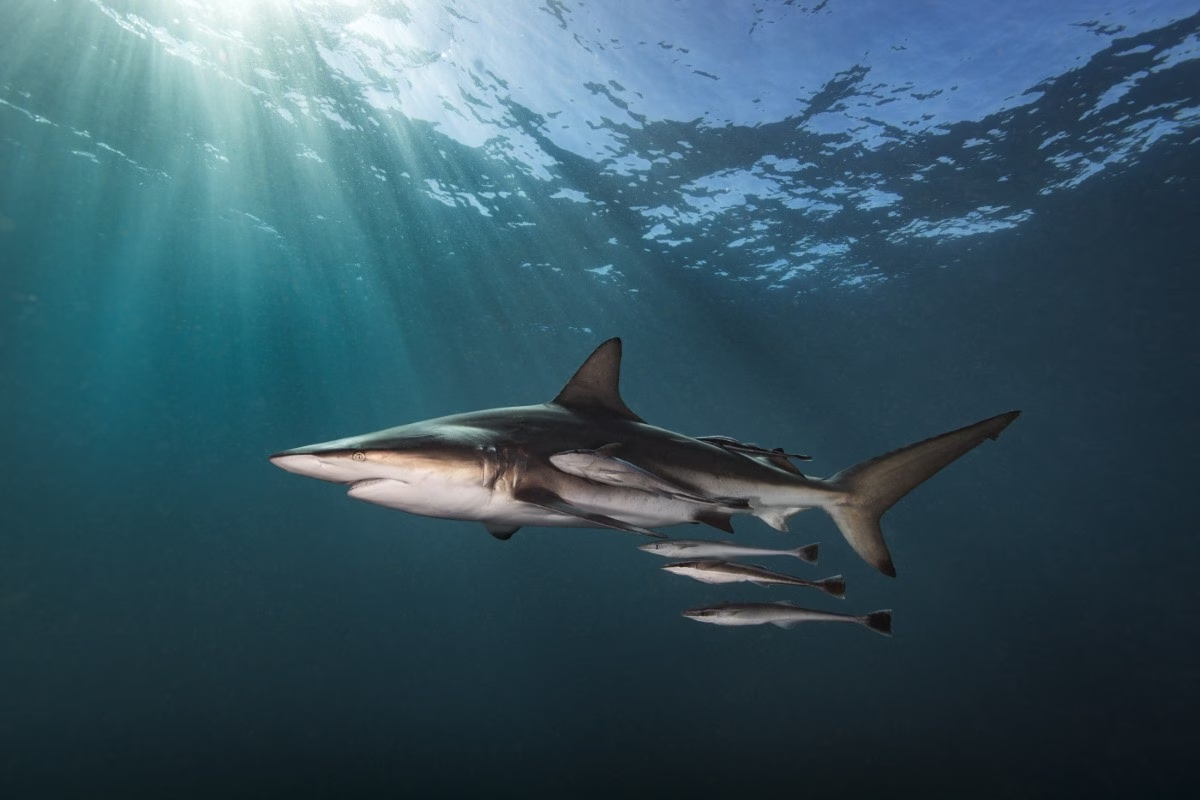
The most notable shark inhabitants are Atlantic blacktip sharks, a species that researchers have been studying in Ilha Grande’s waters. In a rare natural event, scientists recently filmed dozens of blacktip sharks gathering in one of the island’s bays (Enseada de Piraquara) – an exciting find since blacktips are considered a threatened species. The researchers noted this usually happens in cooler months (May–August) when pregnant female sharks likely enter the warm shallow bay to gestate, attracted by abundant fish schools and higher water temperatures. Importantly, these blacktip sharks are small (mostly 1–1.5 m) and avoid humans – the lead scientist emphasized their presence “does not represent risk for swimmers”. They are focused on fish and breeding, not people.
So, any shark “danger” on Ilha Grande is largely a myth. In fact, the biggest “dangers” in the water here are more about strong currents at certain beaches (Lopes Mendes, for example, can have rip currents – always heed local warnings or lifeguards) or jellyfish stings on occasion. Sharks rarely come near tourist swimming areas, and if you’re lucky enough to see one while diving, it’s a memorable wildlife encounter.
Respect for marine life is key: do not fish for sharks (illegal in the marine protected area), and support conservation efforts. The island’s surrounding waters were recently recognized internationally as an important habitat for sharks and rays, leading to projects like the Ilha Grande Bay Shark Project, which involve local communities in protecting these misunderstood creatures. In summary, feel free to enjoy snorkeling and swimming around Ilha Grande without fear – the marine life is friendly, and any sharks are more afraid of you than you are of them.
Practical Tips for Visiting Ilha Grande
- Pack Cash: Bring enough cash (Brazilian Reais) with you to the island. ATMs are scarce – until recently, there were none at all, and now there’s maybe one cash machine in Abraão (which often runs empty or may not accept foreign cards). Most restaurants and shops in Abraão do take cards, but small vendors (beach snack sellers, boat taxis) and tour guides prefer cash. Having ample cash on hand will save you a lot of hassle. Thankfully, Ilha Grande is safe, so carrying cash is not a problem – just use common sense and keep your money secure on hikes or boat trips.
- No Cars – Be Ready to Walk: Ilha Grande is a car-free island – one of its charms is that there are no roads or motor vehicles (aside from maybe one or two service vehicles for emergencies). All transit is by foot or boat. So, pack comfortable walking shoes or hiking sandals. Even if you plan to mostly relax, you’ll likely do some walking to get to beaches or viewpoints, and the village streets are unpaved or cobbled. Also, when you arrive by ferry, there are no taxis, so you’ll be rolling or carrying your luggage from the pier to your accommodation. Pack light if possible, or bring a backpack. The flipside of no cars is wonderfully clean air, quiet nights, and starry skies!
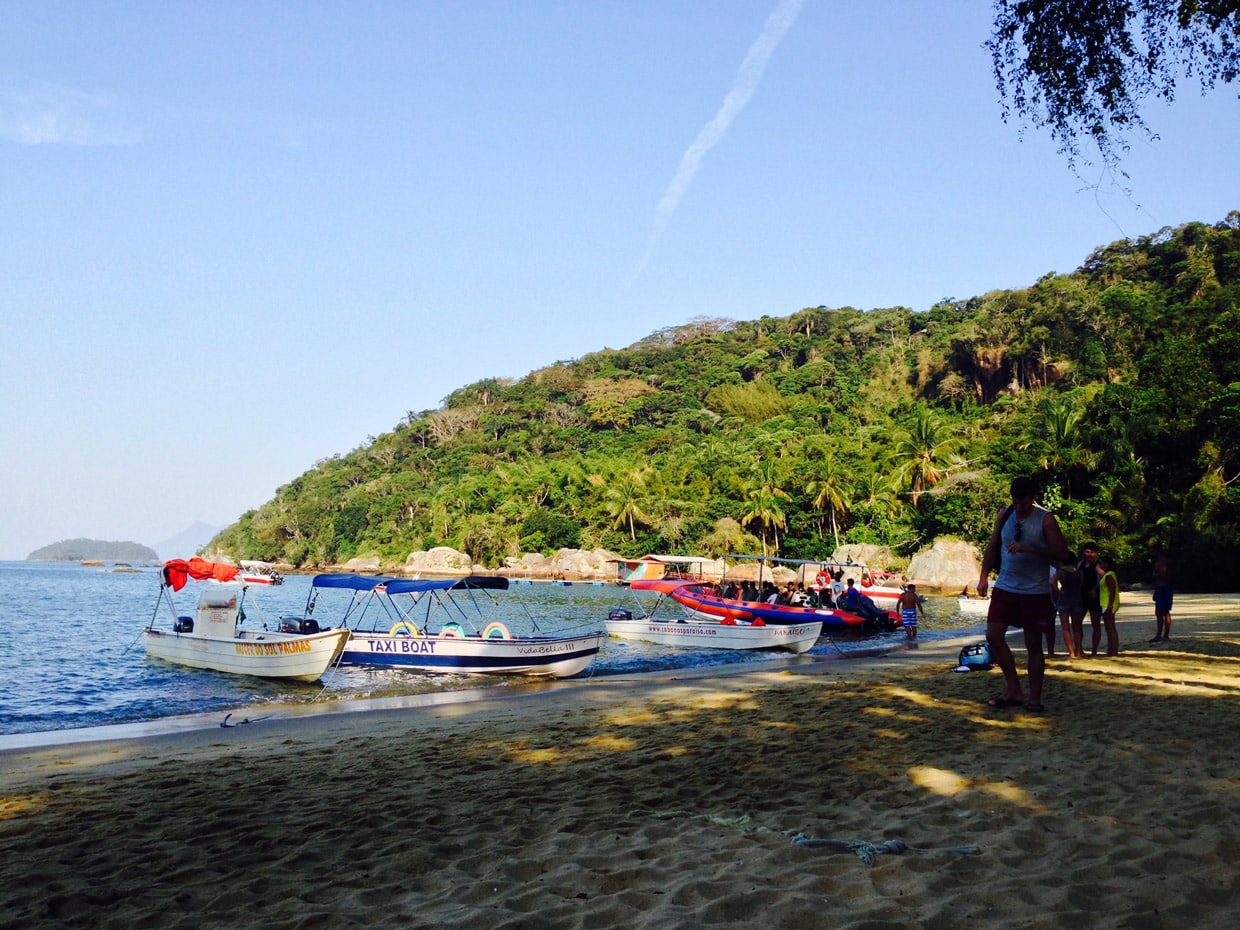
- Insect Protection: The island’s jungles mean mosquitoes and bugs – especially around dusk. Bring a good insect repellent (and after-bite cream just in case). This is important not only for comfort (those bites itch!) but also health – while serious diseases are rare in this region, it’s better to avoid any potential mosquito-borne nasties. Also, consider long pants and sleeves in the evenings if you’ll be near the forest. Don’t let mosquitoes deter you; with repellent and proper clothing, you’ll be fine. And definitely use sunscreen liberally during the day – the tropical sun is strong, even on cloudy days. You’ll likely be in and out of water, so a reef-safe waterproof sunscreen is ideal.
- Stay Hydrated and Snack-Savvy: Exploring under the tropical sun can dehydrate you quickly. Always carry water on hikes (the streams aren’t for drinking). In Abraão, you can refill bottles or buy supplies easily. When venturing to more remote beaches (like Lopes Mendes or others with few facilities), consider packing snacks or a picnic. There may be a vendor or two at popular spots, but as one traveler noted, options can be limited and pricey at the far-out beaches. Bringing some fruit, nuts, or sandwiches from the village is a good idea if you plan a full day out. And of course, don’t litter – keep this paradise as pristine as you found it.
- Safety and Health: Ilha Grande is generally very safe in terms of crime – there’s a small police presence, but the vibe is friendly and theft is rare. Still, it’s wise to lock your room and not leave valuables unattended on the beach (basic precautions anywhere). If you’re hiking, sign in on the trail books if available (some longer trails have registry books at the start) and try not to hike alone at night. For any medical needs, Abraão has a small health clinic. Serious issues would require a boat trip to the mainland, so for peace of mind ensure you have travel insurance and maybe a basic first aid kit for minor cuts or blisters.
- Connectivity: Wi-Fi and cell signal exist in Abraão (most guesthouses have Wi-Fi), but expect slower speeds. Don’t plan on working remotely or streaming HD movies here – use this as an opportunity to disconnect! Outside the main village, signal can be very weak or nonexistent. Let family know you’ll be “off the grid” when hiking or staying in remote parts of the island. Embrace it – read a book, play cards, listen to the waves.
- Respect the Environment: Lastly, remember that Ilha Grande is both a protected natural area and a community. Follow any posted rules (for example, certain beaches limit visitors or ban camping outside designated areas). Support local businesses and tour operators who practice sustainable tourism. Small actions like not picking plants, not feeding wild animals, and carrying out your trash make a huge difference in preserving the island’s beauty. The islanders are proud of their home and its recovery (Ilha Grande went from a place of imprisonment to a haven of freedom and nature). By traveling responsibly, you become part of that positive story.
Ilha Grande truly offers a bit of everything: idyllic beaches for lounging, jungle adventures, fascinating history, and a safe, welcoming atmosphere for all travelers. Whether you’re a solo trekker chasing waterfalls, a couple seeking secluded sands, or a family looking for easy hikes and boat rides, this island delivers with its unique blend of relaxation and exploration. And despite being just a few hours from the hustle of Rio, it feels like a world apart – a tropical paradise lost in time. Once you sink your toes into the white sands or take a dip in those warm green-blue waters, you’ll understand why many visitors end up extending their stay (or returning again and again). So pack your flip-flops, your hiking shoes, and your sense of wonder – Ilha Grande is ready to welcome you into its natural embrace. Boa viagem e aproveite! (Have a great trip and enjoy!)
